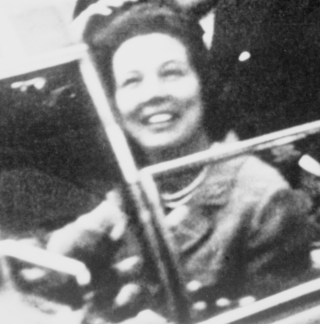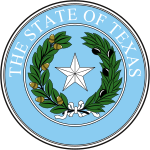
The President's Commission on the Assassination of President Kennedy, known unofficially as the Warren Commission, was established by President Lyndon B. Johnson through Executive Order 11130 on November 29, 1963, to investigate the assassination of United States President John F. Kennedy that had taken place on November 22, 1963.

The governor of Texas heads the state government of Texas. The governor is the leader of the executive and legislative branch of the state government and is the commander in chief of the Texas Military. The current governor is Greg Abbott, who took office in 2015.

On November 22, 1963, John F. Kennedy, the 35th president of the United States, was assassinated while riding in a presidential motorcade through Dealey Plaza in Dallas, Texas. Kennedy was in the vehicle with his wife, Jacqueline, Texas Governor John Connally, and Connally's wife, Nellie, when he was fatally shot from the nearby Texas School Book Depository by former U.S. Marine Lee Harvey Oswald. The motorcade rushed to Parkland Memorial Hospital, where Kennedy was pronounced dead about 30 minutes after the shooting; Connally was also wounded in the attack but recovered. Vice President Lyndon B. Johnson assumed the presidency upon Kennedy's death.

John Bowden Connally Jr. was an American politician. He served as the 39th governor of Texas and as the 61st United States Secretary of the Treasury. He began his career as a Democrat and later became a Republican in 1973.

The single-bullet theory, sometimes known pejoratively as the magic bullet theory, was introduced by the Warren Commission in its investigation of the assassination of U.S. President John F. Kennedy to explain what happened to the bullet that struck Kennedy in the back and exited through his throat. Given the lack of damage to the presidential limousine consistent with it having been struck by a high-velocity bullet, and the fact that Texas Governor John Connally was wounded and was seated on a jumper seat 1+1⁄2 feet in front of and slightly to the left of the president, the Commission concluded they were likely struck by the same bullet.

Ralph Webster Yarborough was an American politician and lawyer. He was a Texas Democratic politician who served in the United States Senate from 1957 to 1971 and was a leader of the progressive wing of his party. Along with Senate Majority Leader Lyndon B. Johnson and Speaker of the House Sam Rayburn, but unlike most Southern congressmen, Yarborough refused to support the 1956 Southern Manifesto, which called for resistance to the racial integration of schools and other public places. Yarborough voted in favor of the Civil Rights Acts of 1957, 1960, 1964, and 1968, as well as the 24th Amendment to the U.S. Constitution, the Voting Rights Act of 1965, and the confirmation of Thurgood Marshall to the U.S. Supreme Court. Yarborough was the only senator from a state that was part of the Confederacy to vote for all five bills.

The Texas Senate is the upper house of the Texas Legislature, with the Texas House of Representatives being the lower house. Together, they compose the state legislature of the state of Texas.
James Thomas Tague was a car salesman who received minor injuries during the assassination of United States President John F. Kennedy in Dallas, Texas, on November 22, 1963. Tague received a minor wound to his right cheek caused by tiny pieces of concrete debris from a street curb that was struck by fragments from a bullet that was fired at Kennedy. Besides Kennedy and Texas Governor John B. Connally, Tague was the only other person known to have been struck as a result of gunfire at Dallas's Dealey Plaza that day.

Robert Schwarz Strauss was an influential figure in American politics, diplomacy, and law whose service dated back to future President Lyndon Johnson's first congressional campaign in 1937. By the 1950s, he was associated in Texas politics with the faction of the Democratic Party that was led by Johnson and John Connally. He served as the Chairman of the Democratic National Committee between 1972 and 1977 and served under President Jimmy Carter as the U.S. Trade Representative and special envoy to the Middle East. He later served as the Ambassador to Russia under President George H.W. Bush. Strauss also served as the last United States Ambassador to the Soviet Union.

Benny Frank Barnes is an American real estate magnate, politician, and crisis manager, who formerly served as Speaker of the Texas House of Representatives from 1965 to 1969 and the 36th Lieutenant Governor of Texas from January 21, 1969, to January 16, 1973, for two two-year terms. He was a vice-chair and top fund-raiser of John Kerry's presidential campaign. Barnes was one of only eight persons who raised over $500,000 for Kerry.

This article considers the detailed timeline of events before, during, and after the assassination of John F. Kennedy, the 35th president of the United States.

Thomas Terry Connally was an American politician, who represented Texas in both the U.S. Senate and the House of Representatives, as a member of the Democratic Party. He served in the U.S. House of Representatives from 1917 to 1929, and in the U.S. Senate from 1929 to 1953.

Clinton J. Hill is a former U.S. Secret Service agent who served under five United States presidents, from Dwight D. Eisenhower to Gerald Ford. Hill is best known for his act of bravery while in the presidential motorcade on November 22, 1963, when President John F. Kennedy was assassinated in Dallas, Texas.

Idanell Brill Connally was the First Lady of Texas from 1963 to 1969. She was the wife of John Connally, who served as Governor of Texas and later as Secretary of the Treasury.

The 1968 Texas gubernatorial election was held on November 5, 1968, to elect the governor of Texas. Incumbent Democratic Governor John Connally did not run for reelection to a fourth term, so the election pitted Democrat Preston Smith against Republican Paul Eggers. Smith was easily elected, winning 57% of the vote to Eggers' 43%.

The 1966 Texas gubernatorial election was held on November 8, 1966, to elect the governor of Texas. Incumbent Democratic Governor John Connally was easily reelected to a third term, winning 73% of the vote to Republican T. E. Kennerly's 26%. Connally swept all 254 counties in this election and was inaugurated for his third term on January 17, 1967.

The 1962 Texas gubernatorial election was held on November 6, 1962, to elect the governor of Texas. Incumbent Democratic Governor Price Daniel was running for reelection to a fourth term, but was defeated in the primary by John Connally. Although Connally was easily elected, Republican Jack Cox's 46% of the vote was the highest received by any Republican candidate for governor since George C. Butte in 1924.

The 1928 United States Senate election in Texas was held on November 6, 1928. Incumbent Democratic U.S. Senator Earle Mayfield ran for re-election to a second term.

Edgar Franklin Foreman Jr. was an American businessman and politician who was a member of the United States House of Representatives. He had one term representing Texas's 16th congressional district from 1963 to 1965 and a second term from 1969 to 1971 representing New Mexico's 2nd district, then newly established. He is the most historically recent member of Congress to have represented more than one state during their career.





















